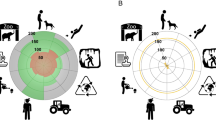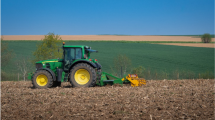Abstract
By applying principles of adaptive management, and by using the valuable information that arthropods provide from assessment and monitoring programs, managers can identify and reduce possible impacts on biodiversity in development projects. In 1996, the Smithsonian Institution's Monitoring and Assessment of Biodiversity program worked together with Shell Prospecting and Development Peru to establish an adaptive management program to protect biodiversity in a natural gas exploration project in a Peruvian rainforest. In this paper, we outlined the conceptual steps involved in establishing an assessment and monitoring program for arthropods, including setting objectives, evaluating the results and making decisions. We also present the results of the assessment using some of groups of arthropods, and summarize the steps taken to identify appropriate groups for monitoring.
Similar content being viewed by others
References
Agosti, D., Majer, J. D., Alonso, L. E. and Schultz, T. R.: 2000, Ants: Standard Methods for Measuring and Monitoring Biodiversity, Smithsonian Institution Press, Washington, DC.
Alonso, A. and Dallmeier, F.: 1998, Biodiversity Assessment of the Lower Urubamba Region, Peru: Cashiriari-3 Well Site and the Camisea and Urubamba Rivers. SI/MAB Series #2, Smithsonian Institution/MAB Biodiversity Program, Washington, DC.
Alonso, A. and Dallmeier, F.: 1999, Biodiversity Assessment of the Lower Urubamba Region, Peru: Pagoreni Well Site: Assessment and Training, SI/MAB Series #3, Smithsonian Institution/MAB Biodiversity Program, Washington, DC.
Alonso, A. and Dallmeier, F.: 2000, Working for Biodiversity. Smithsonian Institution/Monitoring and Assessment of Biodiversity Program, Washington, DC.
Alonso, A., Dallmeier, F., Granek, E. and Raven, P.: 2001, Biodiversity: Connecting with the Tapestry of Life, Smithsonian Institution/Monitoring and Assessment of Biodiversity Program and President's Committee of Advisors on Science and Technology, Washington, DC.
Basset, Y., Novotny, V., Miller, S. E. and Pyle, R.: 2000, ‘Quantifying biodiversity: experience with parataxonomists and digital photography in New Guinea and Guyana', BioScience 50, 899–908.
Campbell, P., Comiskey, D., Alonso, A., Dallmeier, F., Nuñez, P., Beltran, H., Baldeon, S., Nauray, W., De La Colina, R., Acurio, L. and Udvardy, S.: 2002, ‘Modified Whittaker plots as an assessment and monitoring tool for vegetation in a lowland tropical rainforest', Environ. Monit. Assess. 76, 19–41.
Chapin, F. S., Zavaleta, E. S., Eviner, V. E., Naylor, R. L., Vitousek, P. M., Reynolds, H. L., Hooper, D. U., Lavorel, S., Sala, O. E. Hobbie, S. E., Mack, M. C. and Diaz, S.: 2000, ‘Consequences of changing biodiversity', Nature 405, 234–242.
Colwell, R. K.: 1997, EstimateS: Statistical Estimation of Species Richness and Shared Species from Samples. Version 5. User's Guide and Application, Published at: http://viceroy.eeb.uconn.edu/estimates
Colwell, R. K. and Coddington, J. A.: 1994, ‘Estimating terrestrial biodiversity through extrapolation', Phil. Trans. Roy. Soc. London, Ser. B 345, 101–118.
Comiskey, J., Dallmeier, F. and Alonso, A.: 2000, ‘Framework for Assessment and Monitoring of Biodiversity', in: Levin, S. (ed.), Encyclopedia of Biodiversity, Princeton, USA.
Comiskey, J. A., Campbell, P., Alonso, A., Mistry, S., Dallmeier, F., Nuñez, P., Beltran, H., Baldeon, S., Nauray, W., de la Colina, W., Acurio, L. and Udvardy, S.: 2001, ‘Vegetation Assessment of the Lower Urubamba Region, Peru', in: F. Dallmeier, A. Alonso and P. Campbell (eds.), Biodiversity of the Lower Urubamba Region, Peru, SIMAB Series 7, Smithsonian Institution/MAB Biodiversity Program, Washington, DC.
Dallmeier, F. and Alonso, A.: 1997, Biodiversity Assessment of the Lower Urubamba Region, Peru: San Martin-3 and Cashiriari-2 Well Sites, SI/MAB Series #1, Smithsonian Institution/MAB Biodiversity Program, Washington, DC.
Elzinga, C. L., Salzer, D. W. and Willoughby, J. W.: 1998, Measuring and Monitoring Plant Populations, United States Department of the Interior, Bureau of Land Management, Denver, CO.
Erwin, T. L.: 1982, ‘Tropical forests: Their richness in Coleoptera and other arthropod species', Coleopterists Bull. 36, 74–75.
Finnamore, A. T.: 1996, The Advantages of Using Arthropods in Ecosystem Management. A Brief from the Biological Survey of Canada (Terrestrial Arthropods), Provincial Museum of Alberta, Alberta, Canada.
Finnamore, A. T.: 1997, ‘Long-term Monitoring of Arthropod Fauna in the Lower Urubamba Region', in: F. Dallmeier and A. Alonso (eds.), Biodiversity Assessment and Monitoring of the Lower Urubamba Region, PerÚ: San Martin-3 and Cashiriari-2 Well Sites, SI/MAB Series #1, Smithsonian Institution/MAB Biodiversity Program, Washington, DC.
Finnamore, A. T., Winchester, N. N. and Behan-Pelletier, V. M.: 1998, Protocols for Measuring Biodiversity, Arthropod Monitoring in Terrestrial Ecosystems, The Biodiversity Science Board of Canada, Published on line at: http://www.cciw.ca/eman
Goldsmith, F. B. (ed.): 1991, Monitoring for Conservation and Ecology, Conservation Biology Series 3, Chapman and Hall, London.
Hammond, P. M.: 1992, ‘Species Inventory', in: B. Groom-bridge (ed.), Global Biodiversity: Status of the Earth's Living Resources, Chapman and Hall, London.
Hawksworth, D. L. and Ritchie, J. M.: 1993. Biodiversity and Biosystematic Priorities: Microorganisms and Invertebrates, CAB International, Wallingford, England.
Hellawell, J. M.: 1991, ‘Development of a Rationale for Monitoring', in: F. B. Goldsmith (ed.), Monitoring for Conservation and Ecology, Conservation Biology Series 3, Chapman and Hall, London.
Holling, C. S. (ed.): 1978, Adaptive Environmental Assessment and Management, John Wiley & Sons, New York.
Kremen, C., Colwell, R. K., Erwin, T. L., Murphy, D. D., Noss, R. F. and Sanjayan, M. A.: 1993, ‘Terrestrial arthropod assemblages: their use in conservation planning', Conserv. Biol. 7, 796–808.
Kress, W. J., Heyer, W. R., Acevedo, P., Coddington, J., Cole, D., Erwin, T. L., Meggers, B. J. and Pogue, M.: 1998, ‘Amazonian biodiversity: Assessing conservation priorities with taxonomic data', Biod. Conserv. 7(12), 1577–1587.
Lovejoy, T. E.: 1997, ‘Biodiversity: What is it?', in: M. L. Reaka-Kudla, D. E. Wilson and E. O. Wilson (eds.), Biodiversity II: Understanding and Protecting Our Biological Resources, Joseph Henry Press, Washington, DC.
Majer, J. D.: 1987, The Role of Invertebrates in Conservation and Biological Surveys, Western Australian Department of Conservation and Land Management, Perth, Australia.
May, R. M.: 1990, ‘How many species?', Phil. Trans. Roy. Soc. London, Ser. B 330(1257), 293–304.
Meine, C.: 1999, Humans and Other Catastrophes: Perspectives on Extinction, American Museum of Natural History, New York.
Mittermeier, R. A., Myers, N., Gil, P. R. and Mittermeier, C. G.: 1999, Hotspots: Earth's Biologically Richest and Most Endangered Terrestrial Ecoregions, Cemex, Conservation International and Agrupacion Sierra Madre, Monterrey, Mexico.
Myers, N.: 1986, ‘Tropical Deforestation and a Mega-extinctions Spasm', in: M. Soule (ed.), Conservation Biology: The Science and Scarcity of Diversity, Sinauer Associates, Inc., Sunderland, MA.
Pimm, S. and Brooks, T.: 1999, ‘The Sixth Extinction: How Large, Where, and When?', in: Nature and Human Society: The Quest for a Sustainable World, The National Academy of Sciences, Washington, DC.
Rosenzweig, M.: 1996, Species Diversity in Space and Time, Cambridge University Press, New York, NY.
Spellerberg, I. F.: 1991, Monitoring Ecological Change, Cambridge University Press, Cambridge, UK.
Spellerberg, I. F.: 1992, Evaluation and Assessment for Conservation, Chapman & Hall, London.
Stork, N. E.: 1988, ‘Insect diversity: facts, fiction and speculation', Biol. J. Linnean Soc. 35, 321–337.
Whitmore, T. C.: 1997, ‘Tropical Forest Disturbance, Disappearance and Species Loss', in: W. F. Laurance and R. O. Bierregaard (eds.), Tropical Forest Remnants: Ecology, Management and Conservation of Fragmented Communities, The University of Chicago Press, Chicago, IL.
Wilson, E. O.: 1987, ‘The little things that run the world (the importance and conservation of invertebrates)', Conserv. Biol. 1, 344–346.
Author information
Authors and Affiliations
Rights and permissions
About this article
Cite this article
Finnamore, A., Alonso, A., Santisteban, J. et al. A Framework for Assessment and Monitoring of Arthropods in a Lowland Tropical Forest. Environ Monit Assess 76, 43–53 (2002). https://doi.org/10.1023/A:1015268804354
Issue Date:
DOI: https://doi.org/10.1023/A:1015268804354




